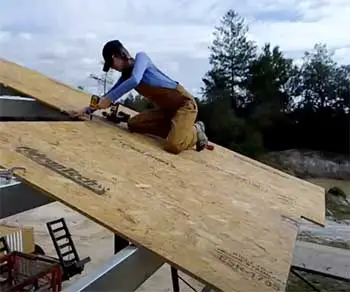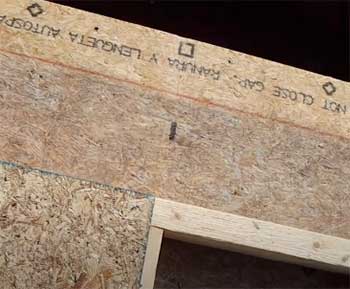Is a new house in your plans? Or want to replace the whole decking of your roof?
Overlooking some crucial points is hard, especially the particular type of decking you want to choose. Considering its thickness level is more important.
Confused about choosing 1/2 or 5/8 roof sheathing?
Well, not only you, a lot of house owners put themselves in this dilemma. Since you have come to the right spot, let us handle this. Here, we will go for an in-depth discussion to help you learn the best roof sheathing as per your need.
A Quick Comparison Table
Can’t wait t learn the fundamental differences? No worries! Take a glance at this table to have a quick idea of both types of roof sheathing.
| Specification | 1/2 Roof Sheathing | 5/8 Roof Sheathing |
| Thickness level | Less thick 5/8 | Thicker than 1/2 |
| Ideal to use | mild weather | extreme weather |
| Durability | Less durable | More durable |
| Rafter Spacing | Less than 20 inches | 24 inches |
| Building Standard | Not always compatible with local building codes | Compatible with local building codes |
| Best wood to use | Plywood or oriented strand board | CDX plywood |
| Price | Lower | Higher |
| Installation cost | Lower | Higher |
| Installation ability | Easy to install | Hard to install |
In-Depth Differences Between 1/2 And 5/8 Roof Sheathing
So, you have already got some general information about /2 and 5/8 roof sheathing. Let’s get into a comprehensive discussion to learn them better.
- Thickness Level
How thick should your roof sheathing be? 1/2 roof sheathing has a reduced thickness level than 5/8 roof sheathing. The thicker the roof decking, the more solid base it will develop.
This will ensure minor bowing between the rafters. As a result, it will develop a better secure surface for your roof material.
- Ideal To Use

Before choosing a particular thickness level of roof sheathing, you must know their ideal usage.
When living in mild weather conditions, using 1/2 roof sheathing appears perfectly okay.
You don’t need highly durable roof decking. A regular one can do the job.
In contrast, more durable roof decking is required if your living location has extreme weather conditions.
5/8 roof sheathing will be a more appropriate choice for handling bad weather such as torrential rain, massive snowstorms, or windstorms.
- Durability
A thicker roof decking can handle a better load and can stay firmly in position even under adverse weather conditions. Hence, 5/8 roof decking will be more long-lasting than 1/2
The added thickness will ensure a minimal chance of bowing between framing. Hence, the quality of your exterior roof material won’t be compromised even after a heavy load.
- Rafter Spacing
Rafter spacing is another crucial point that will help you decide your house’s ideal thickness level. If your home has 24 inches of rafter spacing, installing 5/8 sheathing is the best choice.
It will be reasonably durable to handle the roof loads without falling apart or bending.
In contrast, if your house has 16 to 20 inches of rafter spacing, you can use ½ roof decking without any issues. Their construction will be sturdy enough to take the roof’s lead easily.
However, using either option is often okay for 20 inches of rafter spacing.
- Building Standard
Another important thing is considering the local building codes. Your particular location may have restrictions on using a certain thickness level of roof sheathing.
For instance, it is prohibited to use 1/2-inch in the New York state to deck a roof fully. The minimum thickness level is 5/8-inch.
You may get into trouble for using lower standard roof decking. However, installing 1/2-inch roof decking won’t be any problem if there is no restriction.
- Best Wood To Use

What type of wood are you going to use for roof decking? Generally, plywood and oriented strand board are the best choices for 1/2 Roof Sheathing.
Plywood woods have extreme durability and rigidness. Similarly, you can choose an oriented strand board or wafer board since they are a more affordable option.
Plus, they meet the standard of the Engineered Wood Association (APA).
In contrast, most experts recommend using CDX plywood for 5/8 roof decking since they are strong and economical. As added thickness will cause extra cost, this type of plywood will minimize your installation more than other woods.
- Price
When it comes to home development projects, we need a considerable amount of money. Choosing a roof sheathing often depends on your budget.
You will need more wood since 5/8 roof decking is thicker than ½ roof decking. This will increase the overall cost. The large your home, the more cost you will need to bear.
- Installation cost
Apart from the product cost, you have to consider the installation cost. Compared to 5/8 roof decking, ½ roof decking is more affordable to install. You will need fewer people to set them up.
On the contrary, 5/8 roof decking often requires more professionals to handle. In some cases, you need to use advanced equipment for a better installation, which will increase the cost.
- Installation Ability
How simple is roof sheathing to install? Since 5/8 roof decking is thicker, they are heavier to carry. As a result, you will need more helping people to install them.
Contrastly, ½ roof decking is pretty simple to install. You will need fewer professionals to set them up easily. In addition, you won’t need as much as advanced machines as for 5/8 roof decking.
Which Roof Sheathing Will Be The Best For Your House?

Choosing a particular thickness level of roof decking requires considering your household requirements. If you live in a mild weather condition and have 16-20 inches of rafter spacing, you can use ½ roof decking. They will save you cost.
On the other hand, if your location is in extreme weather conditions and has 24 inches of rafter spacing, selecting 5/8 roof decking is the ideal choice. It is more crucial when your particular location has compulsory building codes.
Frequently Asked Questions (FAQs)
According to most experts, 5/8-inches is the best thickness level for roof sheathing since they are not prone to compromise the exterior roof material and bowing issues between framing.
CDX plywood is one of the best choices for roof sheathing due to its extreme durability and economical pricing.
Oriented strand board is one of the most popular woods used for roof sheathing since they are less expensive than plywood.
Yes, you can use 7/16 OSB for roofing since it is exceptionally durable and retains building integrity for an extended time than other sizes.
Though you can use both kinds of wood for roof sheathing, plywood is a better option than OSB since it doesn’t get prone to have the risk of swollen edges like OSB.
Final Thought
So, which option appears more realistic, between 1/2 or 5/8 roof sheathing?
You can select either option if it fulfills your home requirement and budget. Even though 5/8 roof decking is more durable, you may not need it all the time.
If your house construction is okay with 1/2 roof sheathing, why spend an extra cost, right?
You can utilize the money for other home improvement projects. This article has hopefully given you some useful information about choosing roof decking that suits your needs.
